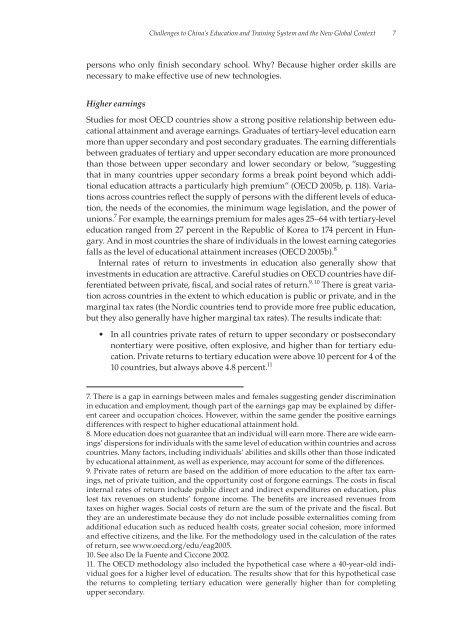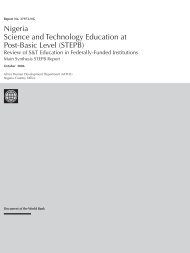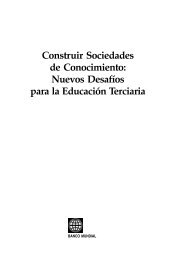Enhancing China's Competitiveness Through Lifelong Learning ...
Enhancing China's Competitiveness Through Lifelong Learning ...
Enhancing China's Competitiveness Through Lifelong Learning ...
You also want an ePaper? Increase the reach of your titles
YUMPU automatically turns print PDFs into web optimized ePapers that Google loves.
Challenges to China’s Education and Training System and the New Global Context 7<br />
persons who only finish secondary school. Why Because higher order skills are<br />
necessary to make effective use of new technologies.<br />
Higher earnings<br />
Studies for most OECD countries show a strong positive relationship between educational<br />
attainment and average earnings. Graduates of tertiary-level education earn<br />
more than upper secondary and post secondary graduates. The earning differentials<br />
between graduates of tertiary and upper secondary education are more pronounced<br />
than those between upper secondary and lower secondary or below, “suggesting<br />
that in many countries upper secondary forms a break point beyond which additional<br />
education attracts a particularly high premium” (OECD 2005b, p. 118). Variations<br />
across countries reflect the supply of persons with the different levels of education,<br />
the needs of the economies, the minimum wage legislation, and the power of<br />
unions. 7 For example, the earnings premium for males ages 25–64 with tertiary-level<br />
education ranged from 27 percent in the Republic of Korea to 174 percent in Hungary.<br />
And in most countries the share of individuals in the lowest earning categories<br />
falls as the level of educational attainment increases (OECD 2005b). 8<br />
Internal rates of return to investments in education also generally show that<br />
investments in education are attractive. Careful studies on OECD countries have differentiated<br />
between private, fiscal, and social rates of return. 9, 10 There is great variation<br />
across countries in the extent to which education is public or private, and in the<br />
marginal tax rates (the Nordic countries tend to provide more free public education,<br />
but they also generally have higher marginal tax rates). The results indicate that:<br />
• In all countries private rates of return to upper secondary or postsecondary<br />
nontertiary were positive, often explosive, and higher than for tertiary education.<br />
Private returns to tertiary education were above 10 percent for 4 of the<br />
10 countries, but always above 4.8 percent. 11<br />
7. There is a gap in earnings between males and females suggesting gender discrimination<br />
in education and employment, though part of the earnings gap may be explained by different<br />
career and occupation choices. However, within the same gender the positive earnings<br />
differences with respect to higher educational attainment hold.<br />
8. More education does not guarantee that an individual will earn more. There are wide earnings’<br />
dispersions for individuals with the same level of education within countries and across<br />
countries. Many factors, including individuals’ abilities and skills other than those indicated<br />
by educational attainment, as well as experience, may account for some of the differences.<br />
9. Private rates of return are based on the addition of more education to the after tax earnings,<br />
net of private tuition, and the opportunity cost of forgone earnings. The costs in fiscal<br />
internal rates of return include public direct and indirect expenditures on education, plus<br />
lost tax revenues on students’ forgone income. The benefits are increased revenues from<br />
taxes on higher wages. Social costs of return are the sum of the private and the fiscal. But<br />
they are an underestimate because they do not include possible externalities coming from<br />
additional education such as reduced health costs, greater social cohesion, more informed<br />
and effective citizens, and the like. For the methodology used in the calculation of the rates<br />
of return, see www.oecd.org/edu/eag2005.<br />
10. See also De la Fuente and Ciccone 2002.<br />
11. The OECD methodology also included the hypothetical case where a 40-year-old individual<br />
goes for a higher level of education. The results show that for this hypothetical case<br />
the returns to completing tertiary education were generally higher than for completing<br />
upper secondary.
















